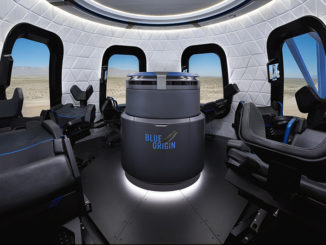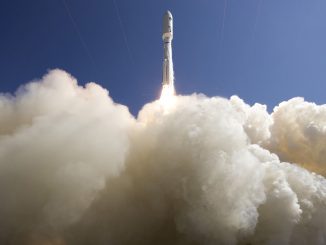EDITOR’S NOTE: Updated at 0145 GMT (9:45 p.m. EDT) after docking.

A Russian Progress resupply and refueling craft launched Monday from the Baikonur Cosmodrome in Kazakhstan, riding a Soyuz booster into orbit on a perfectly-timed departure that set the stage for an on-target docking with the International Space Station less than four hours later.
The Progress MS-09 cargo carrier lifted off atop a Soyuz-2.1a rocket at 2151:34 GMT (5:51:34 p.m. EDT) Monday from the historic spaceport on the Kazakh steppe. Riding nearly a million pounds of thrust, the Soyuz rocket tilted toward the northeast, quickly exceeding the speed of sound and casting an orange glow over the Baikonur Cosmodrome, where liftoff occurred at 3:51 a.m. local time Tuesday.
The three-stage Soyuz rocket released the Progress MS-09 spacecraft around nine minutes later. Following pre-programmed commands, the cargo craft promptly extended its power-generating solar panels and navigation antennas.
A series of thruster firings by the Progress spaceship began in the first hour of the mission, with a major rocket burn around 44 minutes after liftoff to begin adjusting its orbit to match the path of the space station.
The freighter completed an automated radar-guided link-up with the station’s Pirs docking compartment at 0131 GMT Tuesday (9:31 p.m. EDT Monday), less than four hours after blastoff from Kazakhstan, and around eight minutes ahead of schedule.

Russian engineers dispatched the Progress MS-09 spacecraft on the fastest-ever rendezvous with the International Space Station.
The two-orbit rendezvous was made possible by timing the Soyuz rocket’s launch to an instant just before the space station sailed over the Baikonur Cosmodrome.
At the time of liftoff, the space station was orbiting over a point around 370 miles (595 kilometers) southwest of Baikonur. By the time the Progress supply ship reached orbit, the station was orbiting around 1,004 miles (1,615 kilometers) ahead of the cargo craft.
All missions to the space station lift off as Earth’s rotation brings the launch pad under the orbiting lab’s ground track, but the outpost is usually located over a different part of the planet, forcing the visiting cargo or crew capsule to close a greater distance before docking.
Until 2012, Russian cargo and crew flights launched on trajectories that took two days to travel to the space station. The leisurely rendezvous profile spread out the required maneuvers to approach the 450-ton orbiting research complex.
But Russian officials launched a Progress supply ship on an accelerated six-hour rendezvous for the first time in 2012, and began using the fast-track approach for Soyuz crew missions in 2013. The six-hour trip occurs as the space station and visiting spaceship make four orbits of the Earth, while the even quicker journey planned Monday takes place over two orbits.
U.S. cargo vehicles owned by SpaceX and Northrop Grumman typically take several days to reach the space station after launch.
Russia’s first two attempts to demonstrate the two-orbit rendezvous technique during Progress resupply flights last October and in February had to be canceled.
Launch attempts on the last two Progress missions were scrubbed in the final minute before liftoff. In both cases, Russian technicians replaced a control unit inside the Soyuz rocket to correct the problem.
Both missions successfully launched and reached the space station, but they missed narrow launch opportunities that would have permitted fast-track, same-day dockings. Instead, the Progress resupply freighters reverted to longer, two-day rendezvous profiles.
The space station must be flying near the launch base in Kazakhstan to make an expedited rendezvous feasible, and such fortuitous timing is not possible every day.
Russia plans to eventually use the faster, two-orbit rendezvous profile for Soyuz crew missions.
“This technique will be tested several more times before a crew is committed to this launch profile of just two orbits,” said Rob Navias, a NASA spokesperson.
The next two crew launches to the space station, set for Oct. 11 and Dec. 20, will employ the already-demonstrated four-orbit, six-hour rendezvous profiles, Navias said.
The Progress MS-09 supply freighter launched with 5,658 pounds (2,566 kilograms) of fuel, water, food and dry cargo. Here’s a breakdown of the cargo, as provided by NASA:
- 1,168 pounds (530 kilograms) of rocket fuel
- 114 pounds (51 kilograms) of oxygen and air
- 926 pounds (420 kilograms) of water
- 3,450 pounds (1,565 kilograms) of dry cargo
Russian cosmonauts Oleg Artemyev and Sergey Prokopyev, positioned at a control panel inside the station’s Zvezda service module, were ready to take over manual control of the Progress supply ship’s final approach, in the event of a problem with the craft’s automated rendezvous system.
But no such issues occurred, and the Progress accomplished the docking in autopilot mode.
The cosmonauts planned to open hatches leading to the Progress MS-09 spacecraft soon after docking.
Email the author.
Follow Stephen Clark on Twitter: @StephenClark1.



